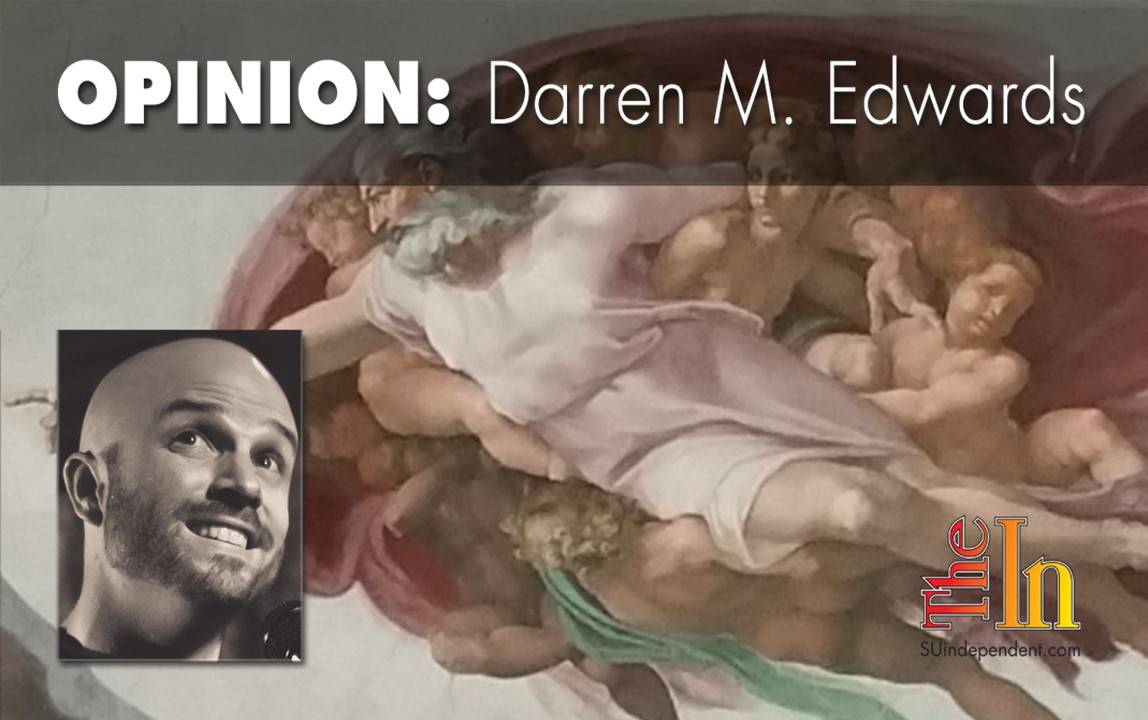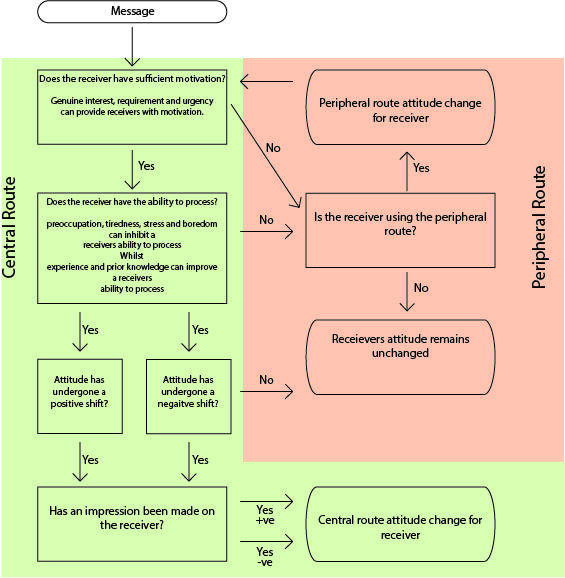 One of the things I enjoyed most about my seven years teaching university English courses was the thrill of teaching argument. Besides the lesson where I made my students debate whether or not Donald Duck should have to wear pants (a delightfully entertaining way to introduce them to the core concepts of argument and persuasion), I most looked forward to teaching how two key ideas played off of each other, cognitive dissonance and the elaboration likelihood model of persuasion (ELM).
One of the things I enjoyed most about my seven years teaching university English courses was the thrill of teaching argument. Besides the lesson where I made my students debate whether or not Donald Duck should have to wear pants (a delightfully entertaining way to introduce them to the core concepts of argument and persuasion), I most looked forward to teaching how two key ideas played off of each other, cognitive dissonance and the elaboration likelihood model of persuasion (ELM).
Cognitive dissonance is the negative feeling we get when evidence for a new idea conflicts with a previously held belief. This feeling usually causes us to discount the new evidence before we’ve truly processed it. Sometimes, the feeling is intense enough to cause a violent reaction.
 ELM is a theory developed by Richard E. Petty and John Cacioppo in the ’80s that explains the different ways information is processed, why people might present their messages in the way they do, and what outcomes can be expected in regard to audience persuasion.
ELM is a theory developed by Richard E. Petty and John Cacioppo in the ’80s that explains the different ways information is processed, why people might present their messages in the way they do, and what outcomes can be expected in regard to audience persuasion.
What does all of this have to do with God and Satan? One day while teaching my students how understanding the ELM could help them work past their audience’s cognitive dissonance, a recently returned Mormon missionary decided to call me out on something. I had just explained how looking at what the ELM teaches us, it could be said that the best way to work past the mental shutdown caused by cognitive dissonance is to present your message subtly, softly, and repeatedly. With indignation, this young man shot up and said, “But that’s how Satan works!” I’ll admit it, I was caught off guard for a moment, and usually, the  only way I could be caught off guard in class was when something crasser than I had intended plopped out of my mouth.
only way I could be caught off guard in class was when something crasser than I had intended plopped out of my mouth.
“Please explain,” I said not really needing the explanation (I was raised LDS and served a mission).
“Satan doesn’t just kick the door in; he gets you to open it inch by inch until, before you know it, you’ve let him into your life.”
Hearing that explanation for the, I don’t know, eight millionth time triggered something in my head. I smiled. I had just been given an opportunity to show the class cognitive dissonance in action.
“Interesting,” I started. “I assume you’re familiar with the parable of the seed.”
“Yes.”
“Can you explain it to the class?”
“Well, faith is like a seed. God only gives you a little, but if you plant that seed, slowly, over time, it will grow and grow until you have faith like a mighty oak.”
“Correct, according to most Western religions, if you let God get his toe in the door, he’ll open it an inch at a time until before you know it, you’ve let him into your life.”
 He scowled at me and sat down with a huff. My intent was not to shake the faith of this young man or any of my students. I wasn’t trying to be the asshole atheist professor you read about in internet memes. I’m more of a deist anyway. I did want to help my students reexamine the way their audience processes (or fails to process) their message.
He scowled at me and sat down with a huff. My intent was not to shake the faith of this young man or any of my students. I wasn’t trying to be the asshole atheist professor you read about in internet memes. I’m more of a deist anyway. I did want to help my students reexamine the way their audience processes (or fails to process) their message.
Teaching argument for all those years has hardwired me to examine the quality of an argument first and whether I agree with it second. As I told my students, it’s possible to disagree with what someone has said while admiring the way they said it. Likewise, I often find myself agreeing with someone’s overall message but furious that they’ve presented a faulty argument in support of it (for an example, look at faulty fear and guilt tactics used in 90 percent of anti-smoking ads).
As I’ve participated in socially progressive movements, I’ve noticed that more often than not we aren’t trying to persuade the opposition. We’re preaching to the choir or rallying the troops. Most of the time, I don’t think we even realize we’re doing it. And, there is a place for those things.
As a friend pointed out to me late one night at a Denny’s (where the best philosophical  discussions happen, right?), there is a need for catharsis and venting within oppressed groups. I agree. But, if we ever want to truly end racism, sexism, ableism, etc. we eventually have to get through to the racists, sexists, ableists, etc. We’re not going to do that by screaming at them. People are rarely brought to or away from any God, group, or mindset by the pompous rantings of a zealot. It can make us feel good to rant like that, especially if we feel we’re shouting against some social evil. It’s cathartic. It lets us release all of the pent up anger and frustration we feel when facing problems bigger than ourselves, problems that often leave us feeling helpless. We can say, “There! I did something. I chucked a rock at the wall of intolerance.” But, other than making us feel good, does it accomplish anything?
discussions happen, right?), there is a need for catharsis and venting within oppressed groups. I agree. But, if we ever want to truly end racism, sexism, ableism, etc. we eventually have to get through to the racists, sexists, ableists, etc. We’re not going to do that by screaming at them. People are rarely brought to or away from any God, group, or mindset by the pompous rantings of a zealot. It can make us feel good to rant like that, especially if we feel we’re shouting against some social evil. It’s cathartic. It lets us release all of the pent up anger and frustration we feel when facing problems bigger than ourselves, problems that often leave us feeling helpless. We can say, “There! I did something. I chucked a rock at the wall of intolerance.” But, other than making us feel good, does it accomplish anything?
There are walls that can be forced down. Many of the biggest steps in social progress and equality have come because people refused to wait for change to happen on its own, but we can’t confuse refusing to sit back and righteous ranting that shows no regard for our audience or the basic principles of argument — like always considering the relationships between you, your audience, and the subject at hand. If we’re only knocking down walls (as important as that is) without persuading the wall builders, the fight for social justice will take  longer than it could as we are forced to divide our efforts between tearing down more walls and stopping the old ones from being rebuilt. The recent spree of states and counties passing lopsided voter regulations is just one example of how a wall that has already been torn down can begin to be rebuilt.
longer than it could as we are forced to divide our efforts between tearing down more walls and stopping the old ones from being rebuilt. The recent spree of states and counties passing lopsided voter regulations is just one example of how a wall that has already been torn down can begin to be rebuilt.
Again, there are absolutely times when screaming at (or past) the opposition is important, like when the goal is catharsis or when a group that is often silenced is finding its voice. And I’m not saying that those of us fighting against racism, sexism, ableism and the lot should have to play nice. I mean, shit, the people clinging to these outdated forms of oppression don’t. But, at times, we should step back and make sure that our methods line up with our end goals. Often, this means presenting our message subtly, softly, and repeatedly. You can’t change a racist overnight, but getting your toe in the door is a hell of a good start.
We would all be justified (those facing oppression and ignorance daily on the front lines most of all) in doing nothing but screaming at anyone who propagates any form of oppression or prejudice. We shouldn’t have to play nice. We shouldn’t have to craft our message to make it more palatable for those who would spit in our faces. But we do.
The idealist side of me wants to trumpet with righteous indignation ‘till I’m hoarse. The pragmatic side of me knows how little that really does. No, we shouldn’t have to cater to the racists, sexists, ableists, and other forms of asshats running rampant across our country. But, if we really want to change the world, if we really want to end these injustices for good, eventually we’ll have to get through to those asshats. That can’t happen unless we try to see things from their point of view, lower our voices, and reach out — not in the way we want to but in the way that they need us to.
Do they deserve that effort? Maybe not. Do we deserve a world were these forms of prejudice are learned about in history books not in everyday life? Yes. Yes we do.







Enjoyed the article Mr. Edwards. To me, sound advise.
Danger Will Robinson!!!!!… (Lost in Space TV show from the late 60s) Then came Star Trek… The Jackie Robinson of TV shows. Suddenly Captain Kirk kisses Uhuru and America has a paradigm shift. Today the media is the Mess-Age… see the Marshall named McCluhan… his words still hold strong after decades when TV Ceaser Mighty Mouse began to rule the roost in every house. NOW the internet is king Kong and growing bigger. There is one simple flaw to your reasoning. A coin has a third side. The consensus reality has been hijacked by the NEO Temple of the Screen – i.e tablets, phones, TVs, computers etc… The left side of our brain is.winning the football game 48 -0 and it’s only halftime. If you cant reach a persons’ right brain then you can’t change the program. Here comes the Oculus VR goggles and alas we go deeper into the Temple of the Screen. Who then is running the software? Perhaps the Wizard of Oz? Perhaps Satan? Or worse… nobody. At this point only Religion has a chance to save our right brain. Crazy as that sounds. Surely it is what the fighting’s all about. Just ask the Mullahs. Great article.
I’ve been surfing on-line greater than 3 hours these days, but I by no means discovered any fascinating article like yours. It is pretty value sufficient for me. In my view, if all website owners and bloggers made good content material as you did, the internet will probably be much more helpful than ever before.|